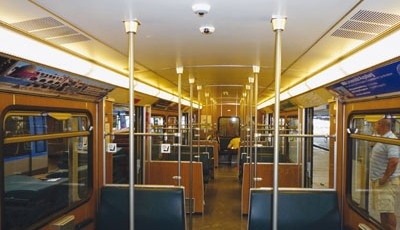Comprehensive Mobile Video Surveillance System for Public Transport
The Münchner Verkehrsgesellschaft (MVG) provides one of the most modern transport systems in the world. More than 500 million passengers travel every year via bus, tram and six sub...

The Münchner Verkehrsgesellschaft (MVG) provides one of the most modern transport systems in the world. More than 500 million passengers travel every year via bus, tram and six subway lines over a network of 95 kilometers with 100 stations and nearly 580 subway cars. Early in 2008, a call for bids was made to equip the subway trains and streetcars with a video surveillance system.
The Munich-based company Indanet won the bid and was commissioned to equip 358 subway cars and 88 streetcars with a digital video surveillance system. Axis, as Indanet‘s partner, contributes the network cameras for the complete system, which consists of an Ethernet communications network, the network recorder with separate storage device, cameras, and evaluation stations. "In this case we had a special requirement that the solution had to run entirely via Ethernet and therefore be integrated into the existing Ethernet of the train units," explains Kurt Stern, Head of Traffic Telematics for Stadtwerke München GmbH (SWM) and MVG.
Dual Streams
Jurgen Fuchs, Indanet‘s general manager responsible for business development, describes the selection criteria for the cameras as follows: "We wanted a compact, rugged IP camera with railway approval for our customers that was easy to install and configure. Of course, it also had to support high-quality video which can be entered as evidence in court to identify offenders. At the same time, the camera needed to deliver two independent data streams: an MPEG-4-compressed stream recorded by our network recorder and stored, as well as an MJPEG stream for live transmission from the vehicle to the control center via a data transmission system."
Axis has a special camera in its portfolio for this requirement: the Axis M3113-R. The palm-sized network camera is particularly robust and delivers high quality digital video images in spite of the rocking and shaking and the high humidity in mass transportation vehicles. "It is the first network camera on the market which incorporates the specific environmental and monitoring requirements for modes of transport," says Edwin Roobol, Regional Director Middle Europe for Axis Communications. He adds that, with this camera, a system can be set up allowing the employees of an alarm center to monitor the events in the vehicle under unusual circumstances. For example, if a vandal sprays the camera with graffiti, shaving foam or something similar, thus covering the camera‘s lens so that the camera can‘t take any more pictures, the Axis M3113-R triggers an alarm.
"The Munich police welcome SWM/MVG‘s gradual expansion of video surveillance in the Munich subway trains, buses and trams. In addition to the preventative aspect, i.e. the curbing of crime, video surveillance also makes an indispensable contribution to the criminal investigation and identification of perpetrators. The better the images, the more chances we have for successful search and identification operations" says Harald Pickert, head of the Crime Division, Police Headquarters, Munich.
Constant Evolution
The opening of the first section of the Munich subway in 1971 and its subsequent expansion to include the Olympic Stadium for the 1972 Olympic Games marked the advent of so-called industrial television. At that time, only stationary cameras were installed in the underground stations, primarily to serve operational needs. By 1980, however, the subway network had grown so much that a central control center for scheduling purposes and station monitoring was put into operation at Marienplatz. To document incidents, each of the five monitoring sites in the subway control center was equipped with a video recorder, which could be started by pressing a button. In February 2004, the subway control center moved from Marienplatz to a new location and was also expanded to become the MVG operations center. The move was also a challenge for the video system. The traffic telematics infrastructure process network had been erected throughout the entire subway system with over 100 network nodes (switches) and more than 5,000 connections (ports).
The deployment of video surveillance systems on buses and trains is now a standard measure for increasing security and reducing vandalism. In Munich, 162 buses are already equipped with cameras. At the beginning of 2008 a call for bids was made to equip the subway trains and streetcars with a video surveillance system. The Munich-based company Indanet won the bid and was commissioned to equip 358 subway cars and 88 streetcars with a digital video surveillance system.
Quick Search
"An example of a successful manhunt was the investigation into property damage caused by graffiti on December 5, 2010 in streetcar 17. The perpetrator and the act were recorded on camera. The images were published in the internal investigation records of the Munich police, which led to a policeman recognizing the perpetrator just days later," says Harald Pickert, head of the Crime Division, Police Headquarters, Munich.













